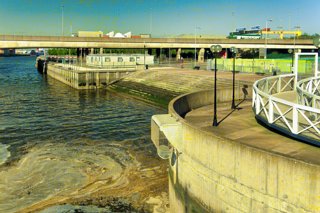THE LAGAN WEIR AND NEARBY MAY 2011
The Lagan Weir in 2011 was a functional but somewhat unremarkable structure in Belfast, Northern Ireland. It served its primary purpose of controlling the water level and flow of the River Lagan, but the old pedestrian bridge that crossed it was widely considered an eyesore. However, the weir's history and impact on the river's environment were significant.
Built in 1994, the Lagan Weir was a key component of the Laganside Corporation's efforts to revitalise the riverfront area. Before its construction, the River Lagan was subject to tidal fluctuations, exposing unsightly mudflats at low tide. These mudflats were not only visually unappealing but also emitted a foul odour, especially during the warmer months. The smell, often described as rotten eggs, was due to the release of hydrogen sulphide gas from the exposed sediment.
The weir helped mitigate this problem by maintaining a consistent water level, preventing the mudflats from being exposed and significantly reducing the odour. However, the river could still smell bad at times in 2011, particularly during low-flow periods or after heavy rainfall when pollutants and debris could accumulate.
The old pedestrian bridge, a utilitarian steel structure, was replaced in the years following your 2011 visit with a modern, architecturally striking bridge. This new bridge greatly enhanced the aesthetic appeal of the weir and the surrounding area, making it a more inviting place for pedestrians and cyclists.
The Lagan Weir's history is intertwined with Belfast's industrial past. The River Lagan was once a vital artery for shipbuilding and other industries, but it also became heavily polluted. The weir, along with other environmental initiatives, has played a crucial role in improving the water quality and revitalising the river.
While the river may still occasionally emit an unpleasant odour, the situation is vastly improved compared to the pre-weir era. The Lagan Weir stands as a symbol of Belfast's commitment to environmental restoration and urban renewal. Its transformation, from a functional barrier to a visually appealing landmark, reflects the city's evolving identity and aspirations.
Built in 1994, the Lagan Weir was a key component of the Laganside Corporation's efforts to revitalise the riverfront area. Before its construction, the River Lagan was subject to tidal fluctuations, exposing unsightly mudflats at low tide. These mudflats were not only visually unappealing but also emitted a foul odour, especially during the warmer months. The smell, often described as rotten eggs, was due to the release of hydrogen sulphide gas from the exposed sediment.
The weir helped mitigate this problem by maintaining a consistent water level, preventing the mudflats from being exposed and significantly reducing the odour. However, the river could still smell bad at times in 2011, particularly during low-flow periods or after heavy rainfall when pollutants and debris could accumulate.
The old pedestrian bridge, a utilitarian steel structure, was replaced in the years following your 2011 visit with a modern, architecturally striking bridge. This new bridge greatly enhanced the aesthetic appeal of the weir and the surrounding area, making it a more inviting place for pedestrians and cyclists.
The Lagan Weir's history is intertwined with Belfast's industrial past. The River Lagan was once a vital artery for shipbuilding and other industries, but it also became heavily polluted. The weir, along with other environmental initiatives, has played a crucial role in improving the water quality and revitalising the river.
While the river may still occasionally emit an unpleasant odour, the situation is vastly improved compared to the pre-weir era. The Lagan Weir stands as a symbol of Belfast's commitment to environmental restoration and urban renewal. Its transformation, from a functional barrier to a visually appealing landmark, reflects the city's evolving identity and aspirations.

THE LAGAN WEIR AND NEARBY MAY 2011